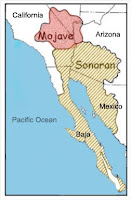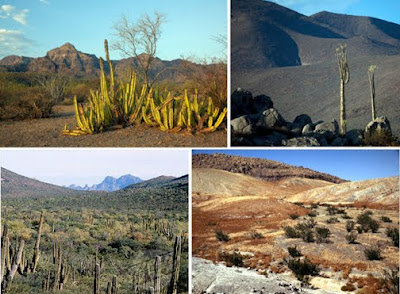 Continuing from the last post regarding the lack of qualifications that Baja California has for a Land of Promise that matches the scriptural record. The climate and terrain, plant life and animals of Baja are far afield from matching the scriptural record. In fact, Baja is part of the Mojave-Sonora Desert, with 2/3 of the Baja Peninsula an extreme desert
Continuing from the last post regarding the lack of qualifications that Baja California has for a Land of Promise that matches the scriptural record. The climate and terrain, plant life and animals of Baja are far afield from matching the scriptural record. In fact, Baja is part of the Mojave-Sonora Desert, with 2/3 of the Baja Peninsula an extreme desert3. Temperatures in Baja vary along the peninsula, but as a rule, temperatures are higher as you travel south, the Pacific coast is cooler than the Gulf coast, and the lower the elevation, the higher the temperature. The desert is virtually absent of frost and summer temperatures often reach above 100° F. Baja has very low precipitation typical of deserts. Mean annual precipitation on the entire peninsula is 6 inches, though there are variances throughout the peninsula, and from year to year. There are two main seasons of precipitation in Baja California. Winter storms bring gentle rains from the Pacific, but because of mountain ranges on the peninsula, these storms usually fail to reach the deserts on the Gulf Coast. The wettest storms on the peninsula come during the late summer or early fall, as chubascos. These tropical hurricanes form over warm water, close to the equator. Facing little resistance, the air masses gain speed and circling winds can top 125 miles per hour. Feeding on the warm waters of the tropical Pacific and Gulf, these storms bring large amounts of moisture. When chubascos reach ground, they often wreak havoc, but many areas of the peninsula depend on these violent storms as their main source of rain. Simply put, seeds brought “from the land of Jerusalem” would not grow in this climate.
 4. Soils are very low in organic matter, and because of the high rate of evaporation, they tend to have high concentrations of salts. In flatter regions of the desert, the tightly packed soils become saturated easily and most of the water runs off during the heavy rains. Creosote bush and bur sage dominate the driest areas of the desert. Gentle sloping areas, known as bajadas, are more conducive to plant diversity. These areas accumulate the mountain erosion, with the resulting soil a mixture of rocks, gravels, sands and silts. The varying particle sizes create soil with an open structure that allows water to penetrate the surface. Again, seeds brought from the Mediterranean climate of Jerusalem would not grow there.
4. Soils are very low in organic matter, and because of the high rate of evaporation, they tend to have high concentrations of salts. In flatter regions of the desert, the tightly packed soils become saturated easily and most of the water runs off during the heavy rains. Creosote bush and bur sage dominate the driest areas of the desert. Gentle sloping areas, known as bajadas, are more conducive to plant diversity. These areas accumulate the mountain erosion, with the resulting soil a mixture of rocks, gravels, sands and silts. The varying particle sizes create soil with an open structure that allows water to penetrate the surface. Again, seeds brought from the Mediterranean climate of Jerusalem would not grow there.5. Plants. The high air, surface and soil temperatures and low humidity of deserts limits plant in animal life to species that are adapted to the harsh terrain. Desert plants tend to have small leaves and many drop their leaves in drought conditions. Some desert plants have dense coverings of hairs that protect their photosynthetic surfaces from intense sunlight and reduce water loss from evaporation. Other plant adaptations include thick leaves, which have less leaf surface area per unit of photosynthesizing tissue, fewer stomata, and structures on stomata that prevent evaporation. Many succulent plants reduce water loss by conducting photosynthesis at night when temperatures are low. Mesquite and paloverde are two trees commonly found on the peninsula. These trees can survive in the poor soil due to nitrogen-fixing bacteria in their roots that provide them with nutrition. Mesquite is common along arroyos and in low-lying deserts. Like many desert plants, mesquite has an extensive shallow root system to capture water quickly, but it also has deep tap roots to capture water from far below the surface. There are more than 110 species of cacti on the peninsula, including the world's largest cactus, the cardon. Some of the more common plants are: the Cirio, Cardon, Century Plant, Ocotillo, Prickly Pear, Candelabra Cactus, Old Man Cactus, Barrel Cactus, Cholla Cactus, Creosote Bush, Datilillo, Elephant Tree, Organ Pipe Cactus, Palo Blanco and Palm tree. This is far from a Mediterranean climate needed to grow the "seeds brought from Jerusalem."
6. Animals. The most common and widespread mammal on the peninsula is the coyote. Baja also has Mule deer, Desert Big Horn sheep, Pronghorn “antelope,” mountain lions, numerous rodents, squirrel and rabbits. There are no unknown animals, or animals like the "ox, and the ass and the horse, and the goat and the wild goat, and all manner of wild animals, which were for the use of man" that Nephi found (1 Nephi 18:25).
7. Water. Baja is considered Mexico’s most arid regions. Water is scare. Extracting water from the ground for agriculture and population causes sea water to intrude into the aquifer, making it brackish and usable. When finding a new valley area, ground water for agriculture and support of a population is believed to last only about ten years. Certainly not enough water available in the entire peninsula to support the millions of people described in the scriptural record (there are only about 2.4 million living in the entire peninsula today, and about 75% of those live along the U.S. border).
(See the next post, “The Fallacy of Extremist Theories—the Baja California Theory, Part III,” for more information on Baja California and how it does not meet the scriptural record requirements for the Land of Promise)




Fact Check:
ReplyDeleteFoul #1: Points #'s 3, 4, and 5 in their entirety, summarized by "seeds brought “from the land of Jerusalem” would not grow in this climate"
Fact #1: The Baja model that this article claims to be critiquing places the land where the seeds would grow (the landing spot of Lehi's party) in the cape area of the Baja, which is a rich, tropical paradise except around the shoreline. Seeds from the middle east would flourish there.
Foul #2: "Baja is considered Mexico’s most arid regions. Water is scare."
Fact #2: Assuming that what was meant here was that water was "scarce" rather than scary, this is true of most of the peninsula, just like the Baja model describes. Remember, the Book of Mormon describes vast wilderness areas and a great land of desolation. If we DIDN'T find inhospitable areas then it would seem more contradictory than the fact that we DO. That being said, the areas the Baja model proposes as the lands NOT described as wilderness are also the areas of the Baja (and they are LARGE areas) where water is plentiful.